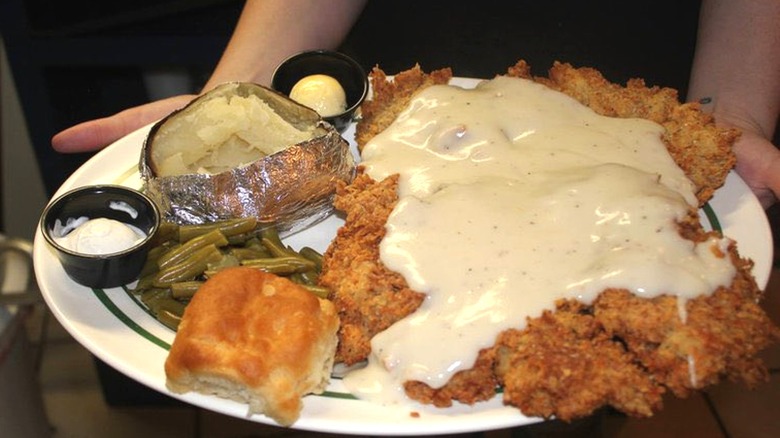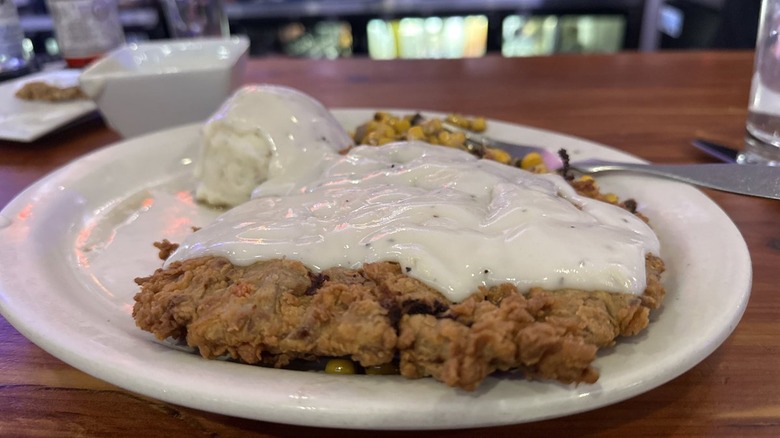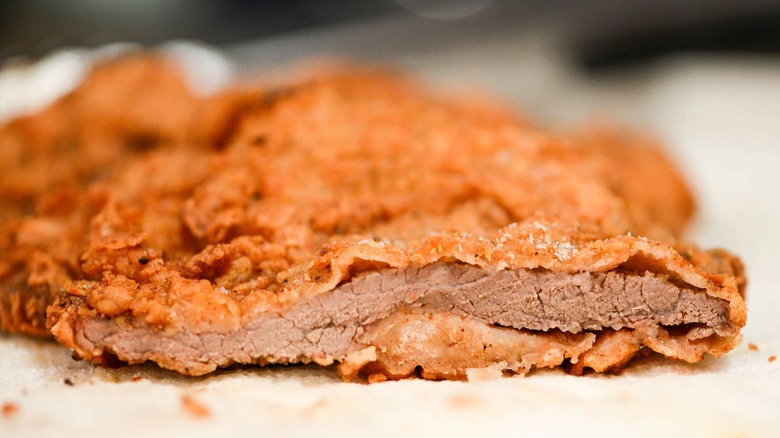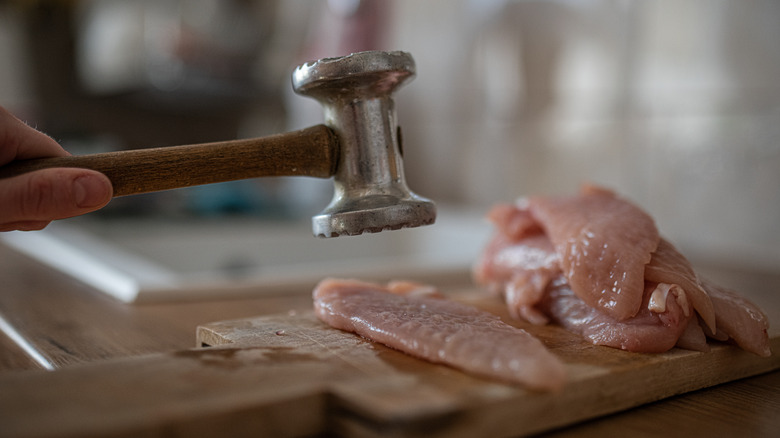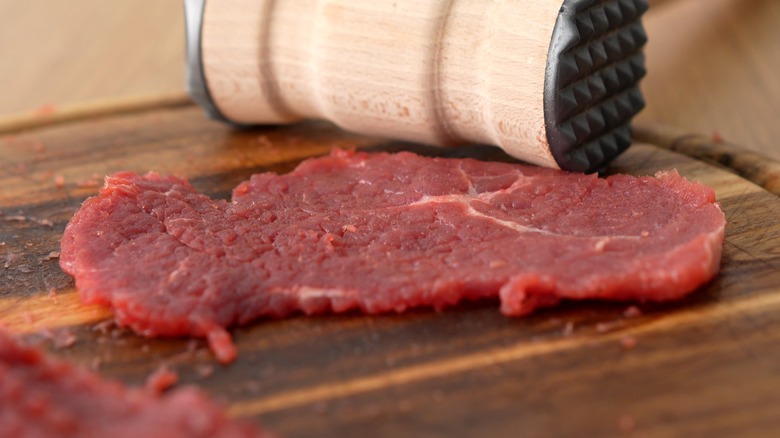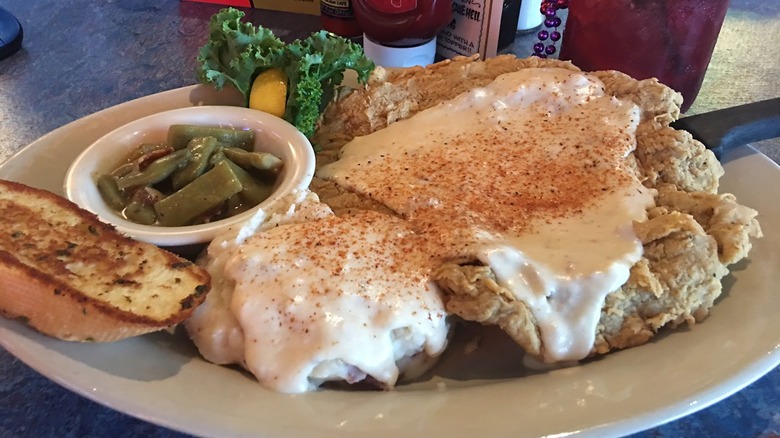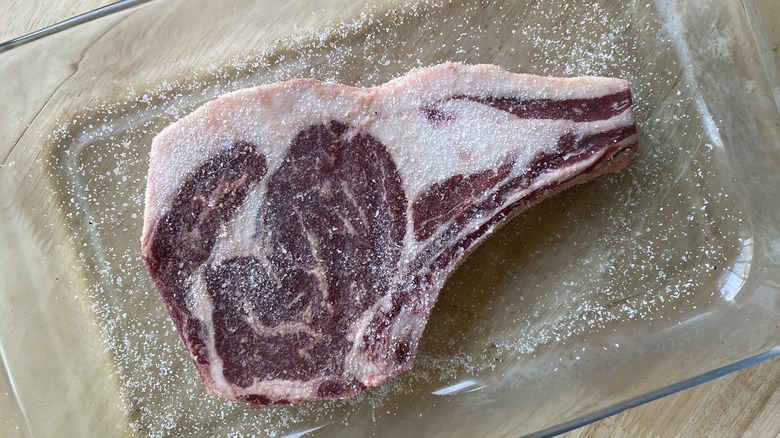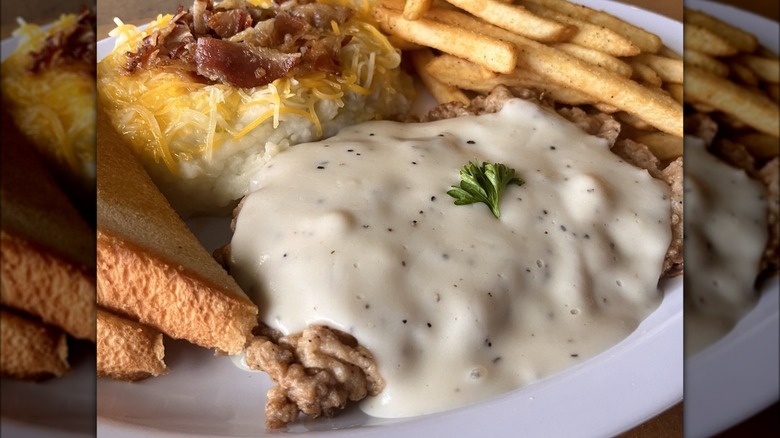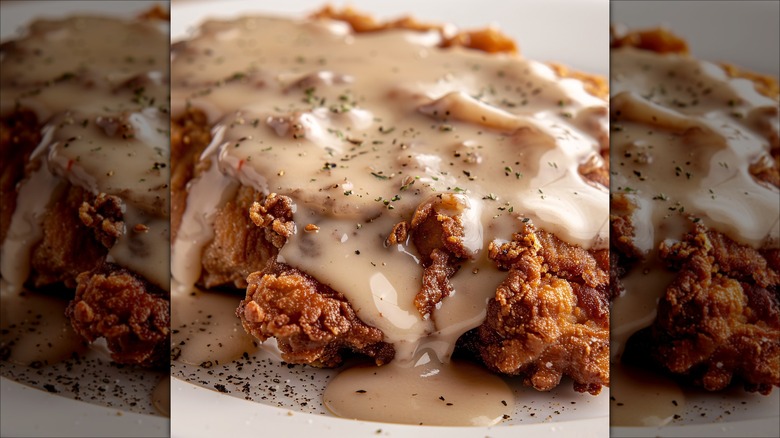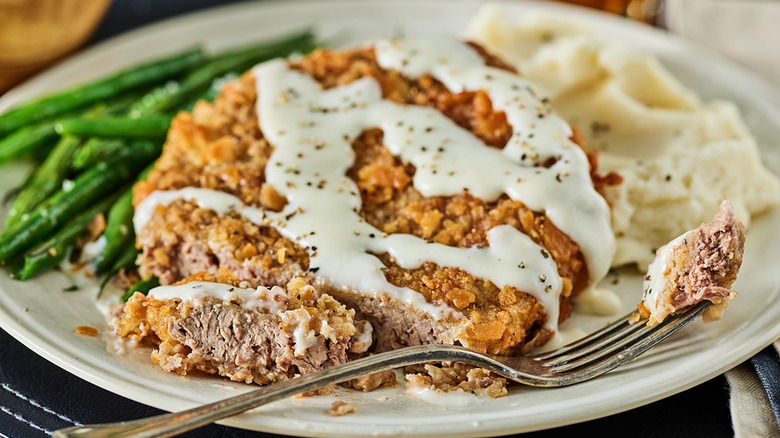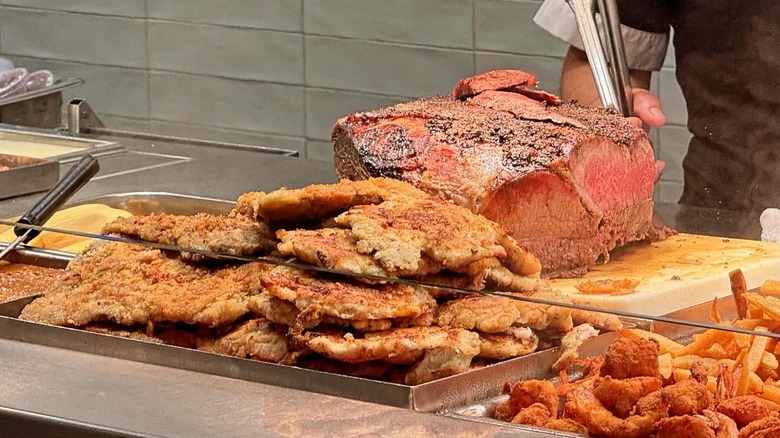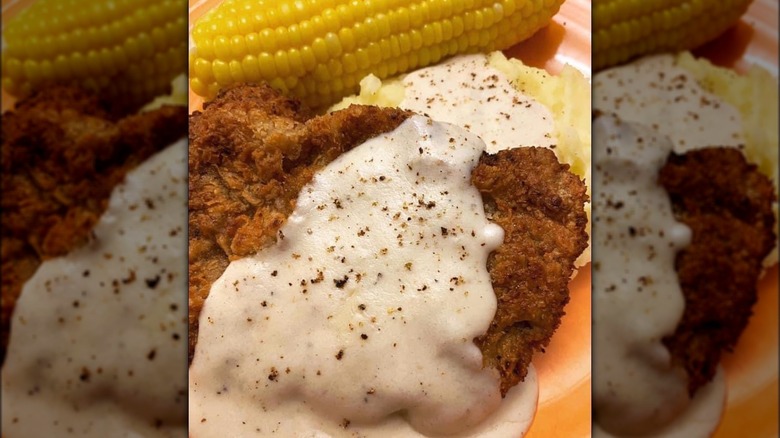Chef-Approved Tips For Making A Restaurant-Quality Chicken Fried Steak At Home
When it comes to Southern comfort food, it doesn't get much better than a chicken fried steak. Done right, a crispy, golden beefsteak (yes, beef, not chicken) bathed in rich white gravy is the very definition of a carb indulgence and definitely something for which we are eternally grateful to its spiritual home of west Texas and Oklahoma. However, whipping up the dish for yourself can prove tougher than you'd think.
Technically speaking, breading and frying the meat is straightforward enough. On the surface, making a white gravy is also pretty easy, only requiring a mix of flour, butter, milk, and seasoning. Where the challenge really lies is in making a chicken fried steak as delicious as those plated up in an actual restaurant. Like a lot of seemingly simple dishes, chicken fried steak never quite hits as hard at home as it does when it's served piping hot from a professional kitchen.
Fortunately, we have a solution. Exhausted by subpar attempts at chicken fried steak, we went straight to the experts to discover their insider secrets. Eager to take your next attempt from zero to hero? With the help of Derrek Long, executive chef at Oklahoma's FLINT Kitchen & Bar, and Bob Bennett, executive chef at Zingerman's Roadhouse in Ann Arbor, we've broken down how to make a top-tier chicken fried steak.
1. Buttermilk is used as a marinade
If you want a good chicken fried steak, buttermilk is key. Thanks to its natural, mild acid, this tangy milk tenderizes the meat without altering the texture, and leaves it extra juicy. To maximize its usefulness, sometimes the meat is even left to marinate in buttermilk for several hours in the refrigerator before it's dipped in breading and fried.
At Zingerman's Roadhouse, buttermilk is the first step towards a tasty steak. "I am pretty in love with the way we make it at Zingerman's Roadhouse," executive chef Bob Bennett says. "First, we dip it in buttermilk. Then we coat it in seasoned flour." Derrek Long — executive chef at FLINT Kitchen & Bar – uses a similar technique, noting that this is "the best way to bread a chicken fry."
Beyond texture, soaking your meat in buttermilk helps the seasoned flour adhere to the meat. Eggs are also interchangeably used for this step at a lot of restaurants. As Bennett explains, "A lot of the time [restaurants use] the three-step process of flour, egg and then bread crumbs." However, it's worth noting that the protein found in eggs tends to expand in the hot oil, which often leads to loose or flaky breading. Buttermilk reacts differently in the heat, helping your breading stay exactly where you want it — by which we mean on your chicken fried steak and not stubbornly stuck to the pan.
2. The meat is double dipped in breading
Once you're done with your buttermilk, breading your steak isn't as simple as dipping it in the breading and tossing it in the pan. If you want a flavorful, crispy steak, you'll need to approach the breading process with a little bit more TLC. As per Derrek Long, "The best way to bread a chicken fry" typically involves using "a double flour breading."
This isn't overly complicated or time-consuming, but can make a huge difference to the final texture of your chicken fried steak. First, you dredge the steak in your breading mixture (the specifics of which we'll come to in a moment). Then you put it back into that buttermilk mixture and dip it again into your breading mixture. Be sure to remember that second buttermilk dip. Otherwise, the double layer of breading will have nothing to adhere to, rendering it pointless.
Once you're done, we recommend gently shaking off the excess and letting this second layer of breading sit for a moment before rushing to cook your steaks. Again, giving the meat a chance to absorb the extra moisture reduces the risk of your breading falling off while frying. If you really want to up the ante, some people repeat this breading step for a third time. This will increase the thickness of the steak's outer layer, which will in turn make it even more crispy — as long as you follow the other tips for frying your chicken fried steak.
3. Meat is always tenderized to a specific thickness
In some ways, chicken fried steak is a lot like schnitzel. Just like the classic German dish, the meat needs to be extra thin before it's breaded and fried. (Unlike schnitzel, this meat also needs to be beef to technically count as a chicken fried steak, and should also ideally be paired with white gravy — but we'll get to that later). As per FLINT Kitchen & Bar's Derrek Long, we should all be taking our cues from traditional German cuisine and hammering our meat — ideally, with a tenderizer or a meat hammer. "I always tenderize my meats with a hammer in the back until they are about half an inch thick," he says.
If you don't have a tenderizer, you don't need to panic and overnight one just yet (although if you are in the market, here are some of our favorite tenderizers available). In a pinch, the end of a rolling pin or the bottom of a cast iron skillet will get the job done. You could also use heavy sealed cans or the underside of a chopping board. Whatever you use, thinning out the beef will break up some of its connective tissues, leaving you with a juicier, more tender steak. As an added bonus, it also makes it much easier for the beef to absorb your chosen herbs and spices, boosting the final dish's flavor profile.
4. At the same time, it's never overworked
Don't mistake the tip of tenderizing your meat as the green light to start hammering the steak into smithereens. There's a reason why Derrek Long recommends a specific thickness of half an inch. His "biggest tip is to make sure you don't overwork the chicken fry steak in the tenderizing process, or it will fall apart."
Not only can over-tenderizing the meat end up ruining its structural integrity, but it may also dramatically increase your odds of overcooking it. By its very nature, a thin chicken fried steak is going to cook quicker than most cuts of meat. If you make it too thin during the tenderizing process, the more likely it is that you'll cross the line of medium or well done and instead just end up with a dry, tough, flavorless, and depressingly gray slab of meat.
To avoid this, we recommend taking it slow and steady with the tenderizer (or rolling pin, skillet, or whatever you've fashioned into your makeshift meat hammer). Don't leave the final thickness up to chance, either. Pause regularly to check if you're getting close to that half-inch goal — and be sure to aim for consistent thickness across the entire cutlet so you don't end up with an unevenly cooked chicken fried steak.
5. They don't go easy on the seasoning
Flavorful chicken fried steak doesn't happen by accident. The professionals treat their seasoning like a science and don't exactly go light with the herbs or spices. While everyone has their personal preference, Derrek Long has a tried-and-tested formula for the tastiest dish possible. "I think the classic seasonings need to make their appearance," he says, listing his standard selection as garlic powder, black pepper, onion powder, and paprika.
Zingerman's Roadhouse executive chef, Bob Bennett, has a different approach. His go-to combo of "salt, pepper, and cayenne" has a little bit more of a kick, with the latter doing most of the heavy lifting. Even if this blend doesn't sound right for your tastebuds, the real takeaway here is that there's no one right way to season your chicken fried steak, so you shouldn't be afraid to experiment. However, you can never go wrong with tossing classics like garlic or oregano into your breading — or, if you're feeling adventurous, some people even enjoy adding corn chips to the mix for an extra crunch. If you're a spice lover, you can also try whipping up a Nashville hot chicken fried steak, a hybrid that uses up to three tablespoons of cayenne pepper plus a splash (or two) of hot sauce in your buttermilk marinade.
6. Salt is key
Salt is a key element in the majority of savory dishes, but especially something like chicken fried steak. From the meat to the breading to the gravy, both Derrek Long and Bob Bennett cite salt (Long specifically recommends Kosher salt, which is known for its purity) as a pillar in every single step of the chicken fried steak prep process.
If you want to take it a step further, you can also opt to dry brine your steak ahead of marination and frying. This involves rubbing the steak with salt and leaving it to rest, giving the salt time to dissolve meat proteins, draw out moisture, and form a gel (aka a "brine") that improves the steak's ability to then reabsorb and retain said moisture. Just like tenderizing the meat, this can go a long way in improving the juiciness of your chicken fried steak. It can also improve its overall flavor — especially if you get a head start on your seasoning by adding some of your favorite herbs as well as salt.
7. It's paired with a thick, indulgent gravy
Some people serve their chicken fried steak with green beans. Others pair it with a baked potato, french fries, or rice. At FLINT Kitchen & Bar, it's served with whipped potatoes. Whatever you choose as your side, one thing that's non-negotiable with chicken fried steak is lashings upon lashings of thick, white country gravy.
There are a few ways you can whip this up at home. However, if you want to do it like Zingerman's Roadhouse's Bob Bennett, you'll need to focus on perfecting its creamy texture. "Making it from scratch would be my first suggestion," he says. "Make a stock, and then thicken it with roux." Alternatively, you can follow Derrek Long's approach. "I'm a big fan of enriching the gravy with a heavy cream to add a little more body to the gravy and I always thicken it with a traditional blond roux," he explains.
To make a blond roux, all you need is butter and flour. The former is melted, then flour is whisked into the butter over a low heat for up to five minutes until it adopts a slightly nutty flavor. As per Long, this, combined with the heavy cream, leaves the gravy "rich, indulgent, and overall delicious." He personally also recommends mixing in the "simplest of seasonings," such as salt and black pepper, the latter of which is what gives Southern gravy its recognizable flecks of black.
8. The gravy is seasoned like the meat
One of the reasons chicken fried steak may hit harder in a restaurant than at home is because some chefs are using much more than salt and pepper to season their gravy. A bit like seasoning the beefsteak itself, this depends massively on personal preference — which is why Zingerman's Roadhouse's Bob Bennett suggests being experimental with your herbs and spices. "I think you can have fun with it," he says. "Try different herbs, different stocks, different flavor combinations."
If you don't know where to begin (or you're afraid of going too experimental with your first try), a good place to start is ground black pepper, garlic powder, and cayenne pepper, à la our recipe for Creamy Country White Gravy. Other tasty additions to consider are thyme and onion powder. If you're feeling extra adventurous, you can also try throwing in a splash of hot sauce, Worcestershire sauce, meat drippings or grease, or lard. The latter is often swapped in for butter in traditional Southern gravy, thanks to its improved ability to thicken the sauce.
9. It's deep fried, not pan fried
Considering how thin a chicken fried steak is, you can easily cook it in a pan with a shallow amount of oil and still end up with a delicious dish. However, some people find that this causes the exterior to brown unevenly. If you want a truly indulgent, crunchy exterior, you'll need to deep fry your steak – whether that's in an actual deep fryer, or in a deep cast iron skillet filled with several inches of oil.
The trick to doing this properly is placing each steak into the hot oil and frying for several minutes. You'll then want to flip the steak in the oil (preferably at a temperature of around 375 F) and cook it on the opposite side for the same amount of time. Depending on the size of your fryer or skillet, you may want to fry each steak separately. Overcrowding the pot may lead to you accidentally steaming the steak, impacting the crispiness of the outer layer.
Thanks to the breading, it's usually pretty obvious when your steak is done, with the exterior taking on a golden brown hue and crispy texture. Meanwhile, the interior temperature should hit around 145 F, right on the cusp of medium and medium-well.
10. Specific cuts of meat are used
Diehard meat lovers know that not all steaks are built equal. When you're making chicken fried steak, you need to be even more selective with your cut of meat to get the best results possible. While you can make do with a sliced, tenderized piece of any steak, the most common recommendation is a tenderized slice of rump roast (also known as a cube steak).
If you want to plate up a chicken fried steak like those at FLINT Kitchen & Bar, you'll need to follow Derrek Long's lead and track down a teres major — a small cut taken from the shoulder that's known for its flavor. "I personally use it because it's a naturally tender cut that isn't always utilized," he explains. This isn't necessarily easy to come by, with teres major (of which you only get 2 pounds in every 1,400 pounds of beef) primarily sold at butcher's shops instead of grocery stores.
However, if it's a quality chicken fried steak you're after, you should ideally be picking up your meat at a butcher's shop anyway. "The quality of the product we start with is better than what most folks buy at the grocery store," Zingerman's Roadhouse's Bob Bennett responds when asked why he thinks in-restaurant chicken fried steak is often superior. "The good news, though, is that it is possible to find the good stuff. Finding a local butcher that knows their stuff is a really good start."
11. The meat is fried for a second time
After all the effort of frying your chicken fried steak, we know it's frustrating to return for round two. However, frying your steak twice could be the difference between a tasty yet average final dish, and an über-crunchy, incredibly satisfying meal.
If you want to give it a go for yourself, you'll need to take the chicken fried steak out of the oil as normal in round one. Leave it to cool (preferably on a wire rack) for several minutes, before plunging it back into the oil for a second frying session to remove even more moisture from the breading. Again, once you're done, we suggest leaving it to cool on a wire rack so it can get rid of the extra oil as it trickles off, which will otherwise lead to a soggy batter if left to pool on your chicken fried steak. The whole process may sound laborious, but it's worth the effort for a crunchier finish.
